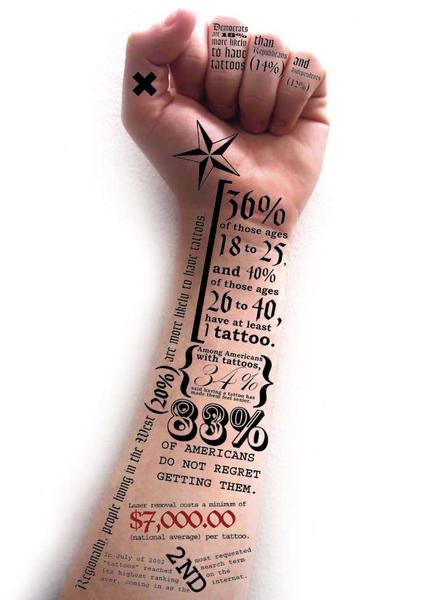
Most who enter the small, dimly-litbuilding on a shabby block near the outskirtsof downtown do so with a tinge ofanxiety, though it is often disguised byconfidence.Framed drawings of tattoos wallpaper therooms, the artistic visions of professionalswho earn a living by prickling ink into theskin of customers. But the images are onlycopies of masterpieces whose original canvaseswere not paper, but flesh, and whoseinstruments were not pencils, but needles.These sketches can be taken down, but themarks the needle makes are meant to stayon their canvases forever.Tattooing is a tradition rooted in history,and even its less-extensive life in theUnited States is marked by several influentialperiods and phases of art. From thebrutish military tattoos that were once sotaboo to the stereotypical “I love mom”biker tattoo, the popularity of inked bodyart has seen its ups and downs.Chris Brown, an artist at the Salty DogTattoo Shop on Berry Street, describedthe recent shift in tattoo trends. He saidin the beginning of American tattooing, itwas an “outlaw thing,” but lately has becomemore about the art.But for the many who view their bodies ascanvases awaiting beautiful masterpieces,there are just as many, if not more, whoonly want to rebel. Brown spoke of thisgroup, the group that is plastered acrossTV screens and has mothers worryingabout their children coming home bandagedfrom their latest, all-too-permanentattempt to be trendy.Two tattoo artists at Liberty Electric Tattooingsaid the impermanence of whitetattoos has been appealing to many youngwomen lately. Artist Jon Hill said in hismore than 15 years of tattooing, he is nowseeing more young people than ever.”I probably do about 100 stars a week,”Hill said.Brown agreed that geometric shapes andtiny, hidden tattoos are big right now.”Girls are coming in here in packs of fiveand only one of them is getting tattooed,and it’s normally like a white star or somethingon the toe,” Brown said.He called these “faux tattoos” becauseof the lack of dedication involved in thedecision-making.”It’s not really a tattoo,” Brown said.”There is no commitment at all. They wantsomething that’s going to fade away.”Brown, who has more tattoos than he cancount, said tattoo history and art is oftenlost on this group of people. To them, hesaid, tattoos are just a novelty.”It’s like the prize at the bottom of aCracker Jack box,” Brown said. “Howlong do you keep that? You tell yourfriend you will keep it forever, but in 20years, where did it go? It’s lost like a loosesock, like a Zippo.”Brown said young people’s decisions toget small, easy-fading tattoos often stemfrom a desire to express independence.”They’re not totally and entirely sure theywant a tattoo,” Brown said. “They want tofeel for a minute that they’re in control oftheir life, but they don’t want to live withthe responsibility of that.”But students who have these types of tattoosdisagree.Laura Kelsey, a senior advertising/publicrelations major, has the outline of threeblue stars on her foot.”I actually thought about it for a reallylong time because I knew it would haveto be something that I would have to livewith for a while,” Kelsey said.She said the three stars have multiplemeanings. They represent the biggest influencesin her life: her mother, father andgrandfather, as well as the Father, Son andHoly Ghost. She said she realizes that tattoosare considered trendy by many, butsaid she thought about her design for twoyears before deciding to have it inked.Daniel Shafer, a junior communicationstudies major, has a cross and fish in themiddle of his upper back. He also saidhe thought long and hard about gettinga tattoo, but said he doesn’t think he willever regret his decision.Brown said this idea of tattoos having aspecial meaning is important to him.The date “1-18-06″ is written on hishand8212;the date his wife found out shewas pregnant. Above the date is a red rosethat he had inscribed the day his daughterwas born.”That’s for me,” Brown said. “It’s personaland it’s imagery. It’s an icon.”But Joe Haasch, who also works at LibertyElectric Tattooing, said sometimes atattoo can just be about art.”A lot of people think they have to getsomething that means a lot,” Haasch said.He said people often come in with verycomplex designs, trying to cram as muchmeaning into the picture as possible.Sometimes, he said, it can just be “whateverimagery you’re turned on by.”While the trend for students seems to besimple tattoo8212;geometric shapes, religioussymbols and the like8212;the, professionalssay the true art comes in the formof the less-subtle, more intricate pieces.Whatever a person chooses to get, the artistsagree that once the needle touches theskin, it changes a person.”It’s kind of a mythical, mysterious thing,”Brown said. “Just the energy with me sittingwith you, holding your arm for anhour and you’re bleeding on me, on mygloves. That’s like transference of energy.”